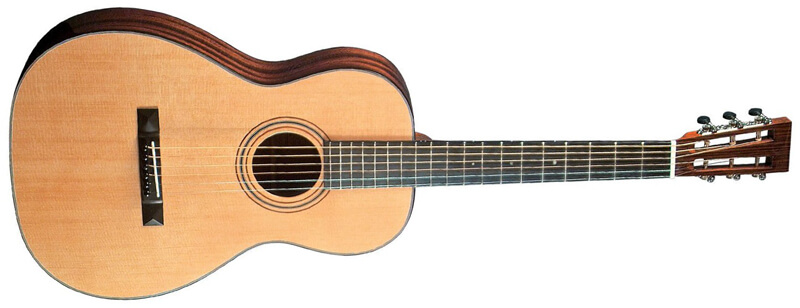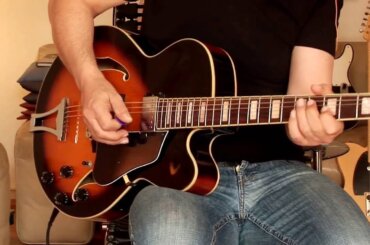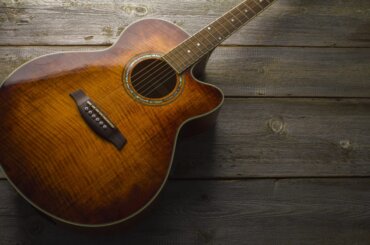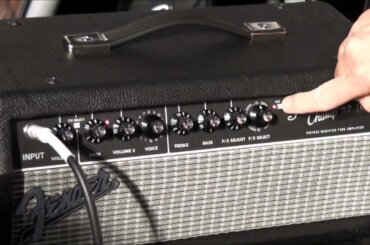For those who are wondering what a Parlor Guitar is, Wait up! It’s different than any other type of guitar that you’ve heard and discussed yet. Do not confuse it with the one you already know about. Although being small, these aren’t low scale guitars. There’s more to the story. So, let’s explore and find answers to the question you have about parlor acoustic guitar.
What is a Parlor Guitar?
With the advent of folk and blues music, the guitar became highly popular. Those not knowing how to play also started buying these instruments. And it is a cliché that not every home that had a guitar, had a professional guitar player at home! Some people like to keep a Guitar at home and play it whenever the inspiration clicks in. Parlor Guitar’s design and budget suit occasional players. Do you know Guitar players who play the notes for satisfaction and not to woo an audience? Those Guitar players, who like to play, but wouldn’t be playing a professional Guitar because it costs way more than their budget.
Parlor Guitars were found in the 19th century. They are also called “Blues Boxes” because of the typical boxy tone they produce. Preferred by folk and blues players, Parlor guitar never gained so much popularity as electric or acoustic Guitars. It is now, in the 20th century that some professional Guitarists have brought them on stage and included them in performances. The other thing that is to be sure about is, no! Parlor Guitars are the same as Travel Guitars.
How is Parlor Guitar different than Travel Guitars?
There are several details that typically distinguishes between travel and parlor Guitars, let’s explore them one by one:
- Body: Body of a travel guitar is shorter and thicker in comparison to the body of a parlor Guitar. In other words, the parlor guitar would sound a little easier than the travel one, even when made of the same material.
- Nut Width: Parlor Guitars have a larger nut width compared to standard-sized guitars. Whilst, travel Guitars almost have the standard nut width.
- Number of Frets: A typical parlor Guitar has 18 frets compared to a travel guitar that should at least have more than 18 frets.
These are the basic points of differences that would help you differentiate a parlor guitar from a travel guitar. Now that you have some idea about the history and what parlor guitars actually are, and you also know the difference between parlor and travel guitars, let’s explore some of the best options that are available in the market currently.
Recommendations for Parlor Guitar
Fender CP 60 S:
CP 60S replaces Fender’s CP 100. With some of the upgraded features, CP 60 S is the perfect replacement for making the limitations of CP 100 seem negligible. Not saying much, explore the specifications of CP 60S yourself…

Construction of Body and Neck:
- Top Wood material: Solid Spruce
- Back and Side Wood: Mahogany
- Scale Length: 24.75 inches
- Fretboard Wood: Rosewood
- Number of Frets: 20
The creation of good looks in this guitar is credited to the use of solid spruce and mahogany in the top and back and side woods, respectively. These good looks are available in two finishes: 1) Glossy and 2) Pearloid Rosette. These Guitars looks are designed keeping in mind the founding year of parlor guitars i.e. Vintage Sunburst finish and Natural finish. A blend of such variant woods gives a smoother experience for a beginner, an intermediate or a professional level player.
Hardware and Sound:
Chrome Tuners make to the list when talking about the Fender-branded headstock of CP 60S. On one side there are these Chrome Tuners that ensure the tuning of Guitar is up to the mark. The bridge makes use of rosewood. To ensure that the Guitar, once tuned, stayed in tune for a long long time, it comes with bronze coated strings from Fender itself.
The overall tone of this Guitar is how it should be in a parlor Guitar, i.e. boxy. Fender CP 60S has a very strong midrange. Whilst the overall tone remains tight and focused, Fender CP 60 S gives a player an immense amount of playability due to its fret design and overall construction.
Gretsch Jim Dandy:
A Guitar is famous because of its tone. Irrespective of whether it’s a Fender make or a Yamaha make or any other company make. Jim Dandy by Gretsch is one such Guitar that has found its place amongst the leading manufacturers because of its tone. The tonal qualities of this Guitar sound extremely pleasing for one’s ears. Before trying to figure out by seeing the specifications in a little bit detail, why is it, what it is? Let me tell you a lesser-known fact about Jim Dandy. This Guitar was a part of the Roots collection by Gretsch in the 1930s. So while hearing its name, if it sounds familiar to your grand-dad you may surely not feel too astonished about it.

Design of Body and Neck:
Jim Dandy comes in its vintage soaked design which makes it look richer than its cost. It has a scale length of 24 inches and a flat top parlor body. The instrument’s lamination at the top back and sides is of Agathis, a rare wood not usually used by the manufacturers. You get a Jim Dandy in three choices i.e. Vintage Sunburst, Vintage White or Chieftan Red Burst. All of these choices have semi-gloss finishes. These have white bindings.
Jim Dandy proved and is still proving to be a model Guitar for beginners. Players who like to jump to inner chords find it easy to play. It’s one of the favorites amongst the ones with short hands, travelers and for those who wish to have a Guitar at home that doesn’t utilize much space. The guitar makes use of Nato wood for creating the neck that’s C in shape and the fretboard material is rosewood. Having known the basics about the body and neck of this guitar, it’s time to check out its hardware and sound.
Hardware and sound:
The Guitar features open care die-cast tuners. At the other end is the rosewood bridge, they both try to keep the guitar in tune for a possibly long time duration. Just perfect for a parlor Guitar usually helpful in jamming and camp-fire sessions, Jim Dandy produces punchy sound during these sessions. The overall tone of Jim Dandy is sweet and boxy that suits blues and old jazz, that of the 30s.
Luna Gypsy Muse Parlor:
Luna Guitars produces lovely parlor guitar models and are very popular for their designs. The mahogany Gypsy Muse Parlor is one of the most popular offerings that show the company’s love and attention to their parlor Guitar lovers. Let’s take a look into the specifications to find out why Luna Guitars is one of the most popular parlor Guitars.

Construction of Body and Neck:
Be it top, back, or sides, the guitar makes use of the mahogany wood. There is just one place where the company has tried another wood apart from Mahagony. Its the fretboard using black ebony. This series is famous because of Luna’s pearl moon phases fret markers, unmatched in the industry. Not only the design but also the detailing is very desirable. This depicts the great job that is done by the manufacturer.
The scale length of this guitar is 25.5 inches. There is a satin finish across the body and neck which gives the guitar a sophisticated air in the much louder sounding air. The C-shaped neck with standard 1.69 inches nut width and 21 number of total frets.
Hardware and Sound:
It is abnormal for a regular guitar to offer a built-in spruce-topped parlor tuner, but as this guitar is all about being eccentric in an already eccentric world, this guitar offers it. At the top, however, there are chrome tuners and at the other end, there is this black walnut bridge.
This Guitar really surprises you when you hear the tone. The overall tone of this guitar is sweet to the point of becoming a powerful punch, enough to blow your mind away because of the emphasis that it lays on its midrange. Not only it does not disappoint anyone who is a newbie in Guitar, but it also has plenty to offer traditional folk players. Mahogany wood offers a little warmer tone than spruce, keeping this in mind Luna Guitar makers have designed this warmer tone offering parlor Guitar for their fans. It’s a treat!
Blueridge BR-341:
This is a little bit controversial because the Guitar has already in its bag the title that says it’s the best travel Guitar in the world. Though there are a lot of differences between a travel guitar and a parlor guitar, there are a lot of similarities as well. One of the similarities is that both types are such that they do not demand from their owners as much as care as an acoustic or an electric guitar owner requires. And because of this characteristic, they are the most favorable ones to carry for any guitarist compared to an acoustic or heavyweight electric guitar.

Let’s check out the specification of this parlor guitar to know how it is different from the list of others.
Construction of Body and Neck:
The texture of this Guitar tells you the premium quality that it possesses. The feel that you get by touching its finished body that resonates to the fullest has a flawless design tells you how super comfortable its players feel when they know that the guitar that they are going to play is Blueridge BR-341. With solid mahogany at the back and sides of the Guitar, there is solid Sitka spruce at the top. This is the combination of wood that is known to produce the standard tone that Guitar is known for, all across the world.
The specialty of Blueridge is despite the use of the standard combination of woods in the construction of its back, sides, and top, it still, somehow manages to remain distinguished. Then your eyes are drawn towards its fretboard material wherein the eccentricity of this guitar lies i.e. use of Top-level ebony wood. Overall the guitar is easier to carry than the guitars that offer the near about the same tone, which makes Blueridge more preferable versus them.
Hardware and Sound:
The ever-mentioned forever inclusive chrome tuners are replaced with nickel tuners. The other side of the balance in tuning is maintained by a rosewood bridge, bone nut, and saddle. This Guitar has a scale length of 24.75 inches and a nut width of 1.875 inches. The Guitar’s sound has impressive top sonic attacks that aren’t usually available with standard parlor guitars.
The resonance is comparatively longer and warmth in the sound is warmer. The punches produced by its sound are something that makes you think that it completely justifies the dreadnaught model and for the least mentioning, the guitar has low-frequencies which is an added benefit. The much absent banjo sound which is a complaint of most parlor guitar players is also been taken care of in this guitar. Overall, this is the guitar that you’d want to dream of as a guitarist to have. So if you are the Newton, this is your apple and you are bound to discover the gravity!
Ibanez PN15:
To prove the odds against themselves, Ibanez has designed this Guitar which is completely out of their comfort zone. Ibanez is a well-known name within the electric Guitar industry section. But to prove their craftsmanship in a sector that is very very far away from their core, Ibanez has taken a task on hand that’s a most challenging one. How much do they succeed in it is what we are out to see!

Construction of Neck and Body
If compared with other parlor guitars, the body of Ibanez PN 15 is bigger, which is not to be taken in either bad or good things but yet it feels necessary to mention just because of the small-sized guitars are mentioned in this list. The top wood is spruce, we have mahogany at the sides and for a change, the back has Sapele wood. The body features a high-gloss mellow brown sunburst finish which is really attractive, even in the photographs. You can also gift yourself a while soundhole rosette if you like to experiment in the design and looks of the guitar.
The neck of this guitar is made up of gloss finished mahogany, however, if you want to google out anything, it is nandu! Nandu is the name of Indonesian wood which is used for making the fretboard of Ibanez PN 15. The guitar houses a total of 18 frets. The nut width of the guitar is 1.65 inches.
Hardware and Sound:
With the standard chrome tuners on one side, you have Ibanez bridge on the other. An Ivorex II nut and saddle take care of the rest. The tuning of the guitar lasts normally that much longer, as much as standard guitar tuning does.
Ibanez impresses us with the sound quality that it offers in mid-range. It has X bracing which makes it resonate even more than most of the others on the list. The guitar has an awesome open tone which makes it easier for the singer to accompany it. The sound, however, isn’t boxy keeping in mind the old tradition league of the parlor guitars.
With Ibanez PN 15, we hereby complete our list of the 5 best Parlor Guitars. The point to take care of while buying a parlor guitar is just that they are smaller in size and anyone can play it.
The Conclusion
Are you looking to gift a guitar to your kid, I am sure Parlor Guitars must be on the list. Apart from that if you are an intermediate level student who is very good at playing but is looking to adopt a faster version of playability than his/her current one, there is probably no other way to gain confidence than trying your hands on a parlor guitar.
The manufacturers’ information does matter much while purchasing a guitar. If you like playing an instrument, regardless of the make, you must buy it. That the only tip you got to take care of while purchasing a parlor Guitar.





